Mezcal makes you sober
A third installment in my series looking at alcohol beverages in Oaxaca.
Continuing the thread from my post about pulque, this entry also discusses the wonders of agave and its intricate sugars. The series started with a discussion of tepache.
Mezcal is a clear distilled liquor made from 40 - 50 species of agave, with an ABV usually above 40%. Many very good mezcales can’t legally use this name (which is protected) and are sold as “agave distillates” or “aquardiente de agave”. Like cheese, some of the best stuff is made without the protected name designation, even if it’s made within the geographic area defined by the D.O. The static rules of protected names and attempts to define “tradition” and “authenticity” often turn these vague concepts into marketing ploys, and do the opposite of assisting traditional knowledge holders. I feel defining tradition is dangerous, and there is rarely consensus over the definition. Tradition is a dangerous word because of its connotation of an unchanging golden age, that never actually existed.
Mezcal is Mexico’s national drink, and about 90% of it is made in Oaxaca. Over 50% of the certified mezcal is exported, mainly to the US, where demand is exploding. As this is happening, supply decreased in 2023, and agave is increasingly being grown as an irresponsible monoculture, with a single, fast-growing species (Espadin) being used extensively. This trend has already played out in the disaster of Tequila production in Jalisco, where a single, genetically uniform species was grown industrially, with predicatably catastrophic results. The hope is that mezcal will not follow suit.
I have only just begun learning about and sampling mezcal, so please pardon my ignorance. There is tons of recent, better informed writing about mezcal, highlighting efforts to promote sustainable, polyculture agave farming, along with brands that are working to pay a fair price to producers who are maintaining these practices and the old tools. These tools and techniques are incredibly varied, and when combined with the diversity of agaves and their long growing time, lead to the most complex and aromatically nuanced distillate out there. I’ll describe a generic overview of the process, but there are countless variations of nearly every step.
Like cheese, mezcal starts with sun, soil, and water. The hundreds of agave species grow very slowly, generally without needing irrigation. They can grow in areas with as little as 10 annual inches of rain, tolerating both hot and cold as well as prolonged drought. They do this by storing scant seasonal rainfall in their massive leaves and core, which is referred to as a piña. The outstretched leaves are like gutters, channeling rain or moisture from the air towards the center, where it drops onto roots that sit just below the soils surface, in the shade of the plant. These leaves are coated in a waxy layer that allows fog to condense, and slide inward, while keeping moisture inside the leaf. When you look at an agave, you are seeing an architecture built around storing water and energy. The geometry of survival in arid landscapes.
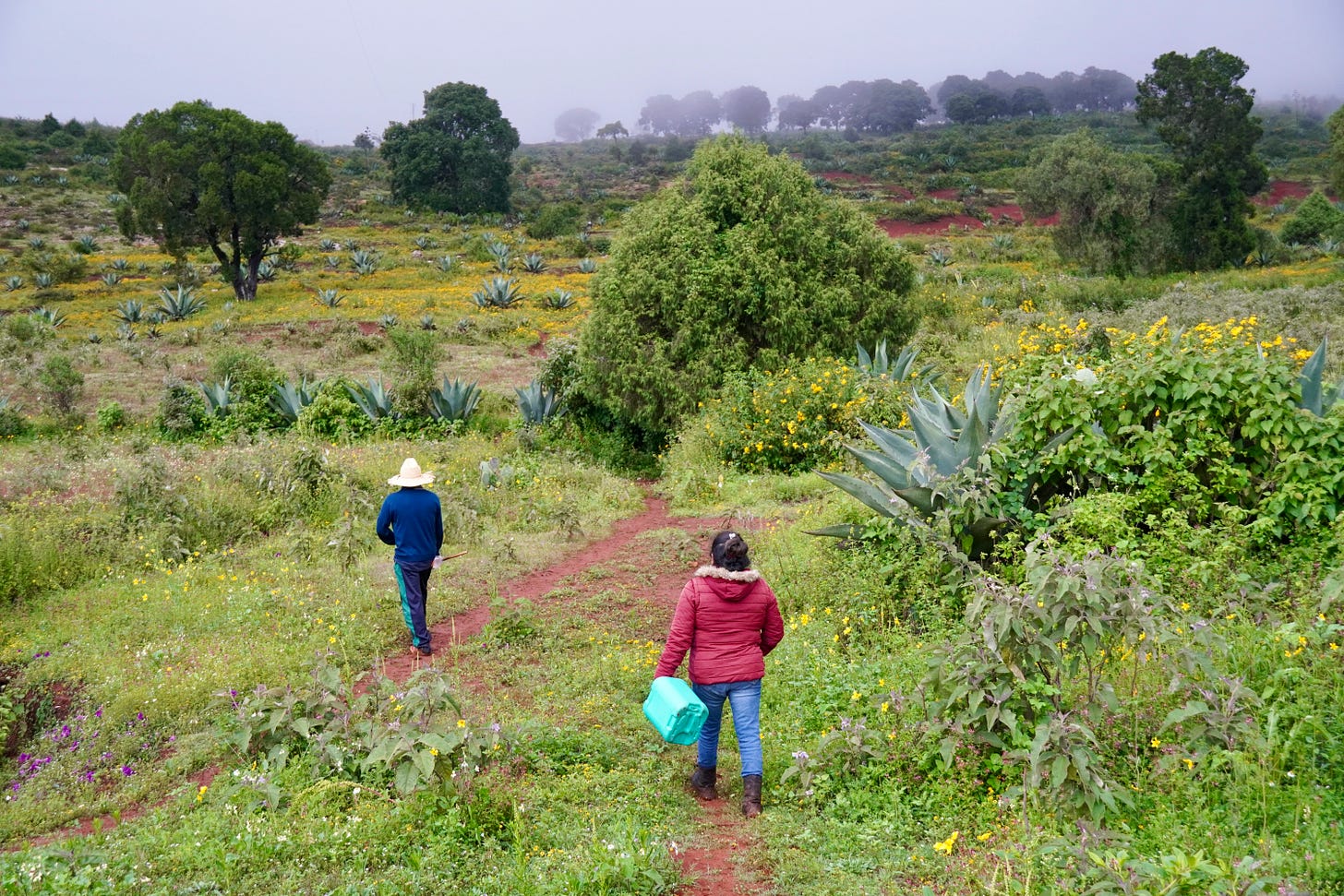
Agaves, pineapples, and some cactus utilize a variation of photosynthesis called crassulacean acid metabolism, or CAM. These plants open their stomata and absorb CO2 at night, when they will lose less water to evaporation. They temporarily store the CO2 in malic acid (which I distinctly tasted in fresh aquamiel). With the return of sun the stomata close, and the stored CO2 proceeds down more standard photosynthetic pathways. When grown with nitrogen fixing mesquite and acacia trees, agave agroforestry is one of the most promising tools for producing biomass to feed livestock, generate fertility via compost, and cover bare soil while sequestering carbon in arid grasslands, deserts, and overgrazed rangeland. As modern agricultural civilizations succeed in following a path that seems designed to create deserts, agave becomes increasingly relevant.
The complex chemistry and diversity of carbohydrates found in agave is the foundation of mezcal’s uniqueness. It is all geared to the moment when the plants flower after 7 - 40 years of growth, sending up a tree-like quiote, which opens its flowers and attracts pollinators with sweet nectar. It is then that jimadors harvest the plant. This is no easy task, as these resilient plants are botanical fortresses, built to stay put. The leaves are hacked off, and the incredibly dense piñas somehow lifted onto a truck, to be taken to the palenque for processing. This starts with roasting, often in a large pit called a horno that has various designs, and materials for lining it. A fire is lit, the type of wood used being another variable. When the amount of coals and heat is deemed sufficient, rocks and the agave fibers remaining from a previous distillation (bagasso) are put on top, then the split piñas are strategically piled on until they make a mound, which is covered with a canvas tarp or woven mats, and sand. The roasting lasts multiple days, a necessary step in converting starches into simpler sugars that can easily be fermented into alcohol.
The main sugar is fructose, but there is glucose as well, released from the complex polymers of sugars found in agave, most importantly fructans such as inulin. Agaves manufacture these by locking water into chains of sugar where it is protected, slowly the loss of moisture. Sugar is not just one thing, that is inherently “bad for you”. There are many sugars, that form many substances that are at the root of fermentations, and life on this planet. The modern drug of table sugar from beets is definitely problematic, to say the least. It’s the pasteurized, homogenized, grocery-store milk of the sugar world. But neither sugars, nor milks, grains, salts, or alcohols are inherently bad. These things have simply been stripped of their natural origins, reduced to their most unhealthy forms by a food system that seems driven to take everything holy and life-supporting and turn it into its opposite.
I’ll now describe the process as I saw it at the palenque of Lalocura, in Santa Catarina Minos, a village known for distilling en barro, in clay pots. This is as opposed to distilling en Alembique, in copper vessels.
The browned piñas are removed from the horno and stacked in piles. We sampled the cooked agave flesh at this point. It was sweet and fibrous like sugarcane, and tasted of caramelized sugars, like a heavily roasted squash or sweet potato. I noticed one pile that was beginning to grow mold, and was told this is done intentionally, allowing fungal growth prior to the mashing and fermenting. This reminds me of certain multi-day cheeses where yeast is allowed to grow on wheels prior to their milling, salting, and shaping into a final form. The cooked agaves are then crushed, sometimes by a large stone wheel pulled around a circular trough by a horse or mule. At Lalocura the crushing is done by hacking up the piñas with machetes and axes, then smashing in a concrete trough with huge wooden mallets. This is the equivalent of crushing grapes for wine; the sugary juice is released from the sacrificial plants.

The mashed up, sugar-rich fiber and juices are put into huge, coopered wooden vats called tinas that appear to be very old. In some places, cow hides are used as ferm vats, likely a continuation of the practice of making pulque in such vessels. Water is added and a little wooden cross is placed in the center of the floating mass, to protect it from evil and ensure a good fermentation. Both of the palenques we had seen this day, along with tasting rooms, had small shrines centrally placed, and actively attended. The vats are covered with woven palm mats or black plastic netting to keep insects out. After one or two days, the mass bubbles in earnest then eventually slows down as the sugars become depleted, having been transformed into alcohol. The mass of fibers forms a cap as the “boiling” subsides. At this point the liquid underneath is called tepache, and I would say it’s like a strong beer.
Unlike most wines/beers/ciders, the plant matter is not removed yet, and secondary fermentations are allowed to begin. I imagine there is a shift of importance here from yeasts to bacteria, which leads to the creation of many aromatic compounds. In putting my face right up to the vat, I detected acetic acid (which tends to be olfactorily domineering), and suspect there is lactic acid as well as a range of the compounds also found in natural wine and sour or more accurately “mixed fermentation” beers. This is another example of the depth of mezcal, where everything is allowed to take its time. The fermentation appears to rely on a community of microbes (a SCOBY) that are cultivated in the palenque, existing in the air and on the tools, and perhaps most importantly, in the wood vats. It appears that a range of “wild” yeasts are involved in the early stages, until the levels of alcohol are more than they can tolerate, with most going dormant as ABV reaches 5 - 6%. Then Sacchromyces strains continue, finishing the alcohol ferm, especially S. cerevisiae, known as brewers yeast. It’s important to note that these are “wild” forms not added through external inoculation with the isolated strains ubiquitous in the beer and wine worlds. It’s likely they are being selected for by the high final alcohol content (of the tepache), temperatures, and the conditions of the palenque itself. Like cheese and so many foods, it’s the continual production of the ferments that feeds the culture and keeps it active. Some use pulque as a starter culture, or backslop with a previous batch of active tepache, especially in cooler regions.
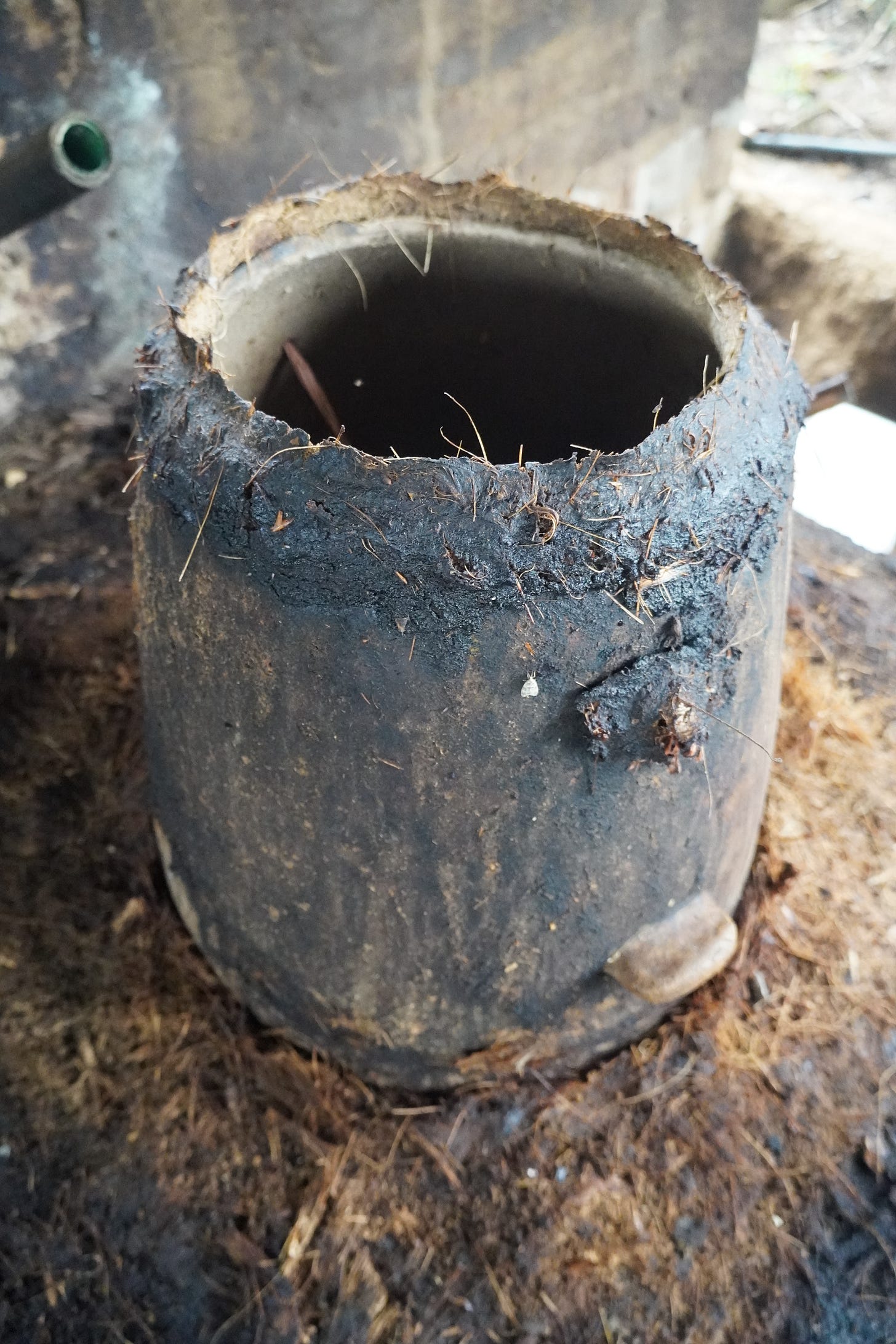
The tepache ends up being fairly high ABV, 12 - 15%. That’s as high as you can generally get with the yeast strains found in most beer and wine. This liquid is then ready for distillation. At Lalocura, this involves a clay vessel called an olla de carga, set within an enclosed chamber where wood is burned below the vessel. On top of the olla, a hollow clay sleeve sits. On top of this a copper bowl is placed, that has cold water flowing through it. As the liquid in the bottom compartment boils, the steam rises through the hollow sleeve, condenses on the cool copper pot, and drips down and out a tube, into an awaiting jug.
After the first round is complete, it is generally distilled a 2nd time, to further concentrate the alcohol and bring the desired flavors forward. But the more times it is distilled after this, the further you get from the flavor of the plant and process, the more it becomes like vodka. There are barrel-aged mezcals, but according to some this is unnecessary, and results in the loss of aromatic complexity. The aging has already taken place, in the years the agave took to grow. The flavors are assembled in the roasting, fermenting, and distillation techniques. Many mezcals are left in glass for months or years, the flavors softening without losing alcohol or the “angel’s share”, the roughly 10% volume loss that is expected with spirits aged in wood barrels. The ABV of more than 40% is perhaps necessary to preserve this aromatic complexity. Mezcal is the first high-proof distillate I have come across that I am convinced needs nothing add. No ice, no water. It’s like camels milk, perfect just as it is. But firm rules as to how we should eat and drink are for fascists and their apologists.
Drink what you like, how you like, when you like.
A lot of the things I stated above are a kind of mezcal dogma, which is countered in this article.
For me, good mezcal is already an exceptional cocktail, the balance and interplay of flavors offered by the sun, the soil, the plants. These ingredients are transferred and transformed by those who care for and harvest agave, and those who carry out its roasting, fermentation, and distillation according to time honored, highly variable practices.
What does mezcal taste like?
Like survival, sweat, and resilience. Like the tears of angels, crying for their fallen comrades, warmed over a campfire.
A big thanks to mi amigo Darinel Silva, for taking me to these palenques, and lending the quote used as the title. “Mezcal makes you sober”.
If you are seeking these kinds of experiences in Oaxaca, I suggest you hit him up. He’ll make sure you leave very, very, sober.






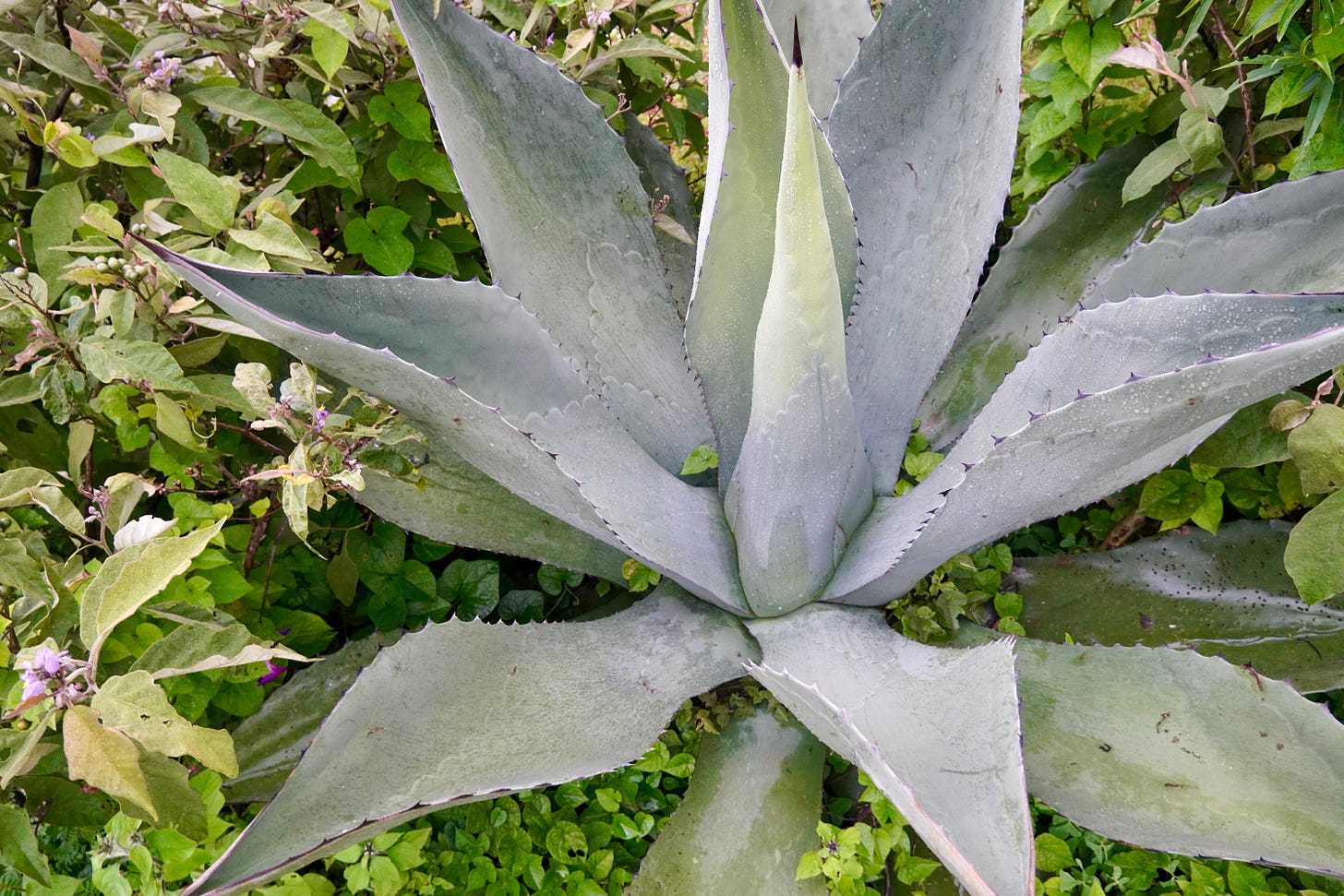

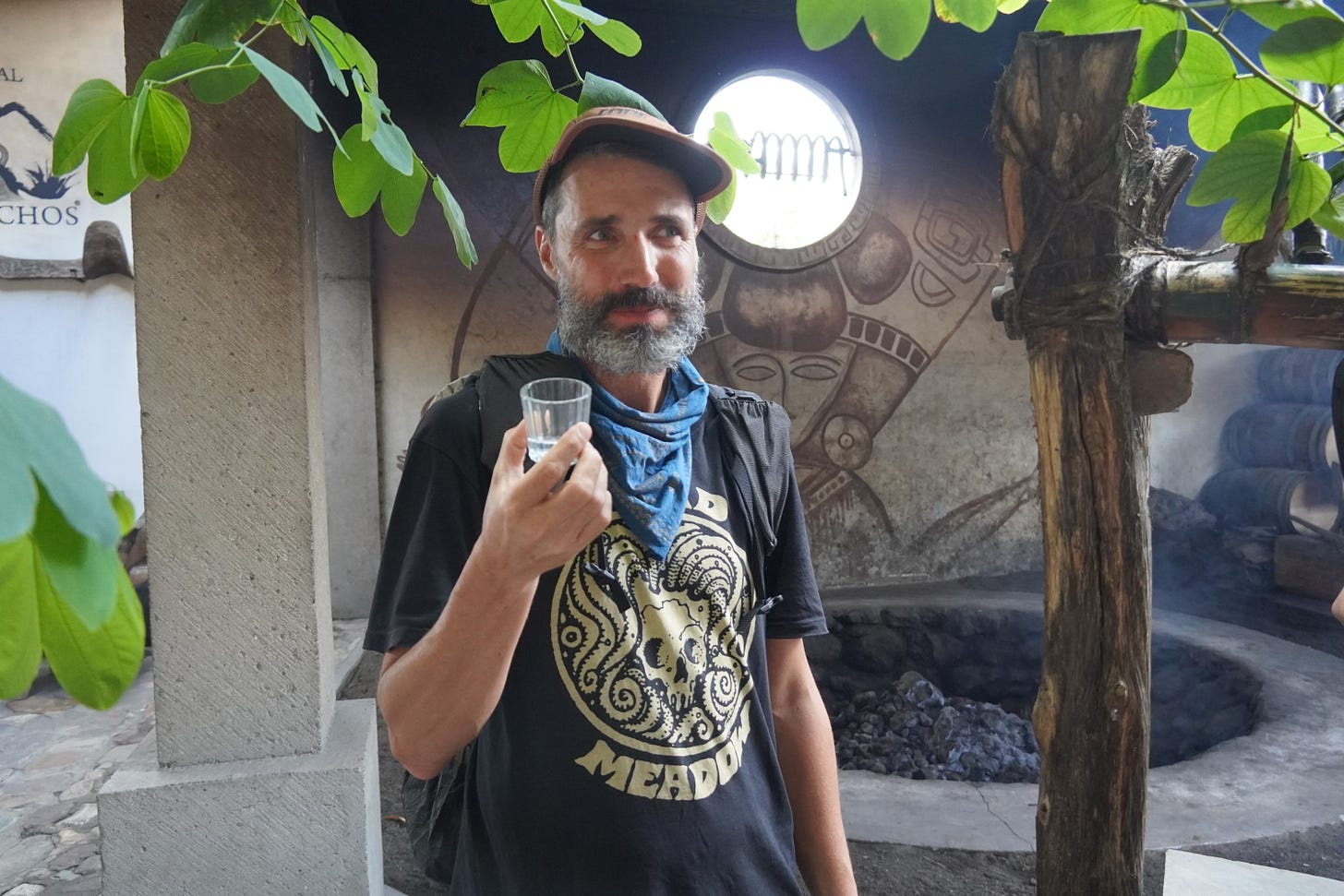
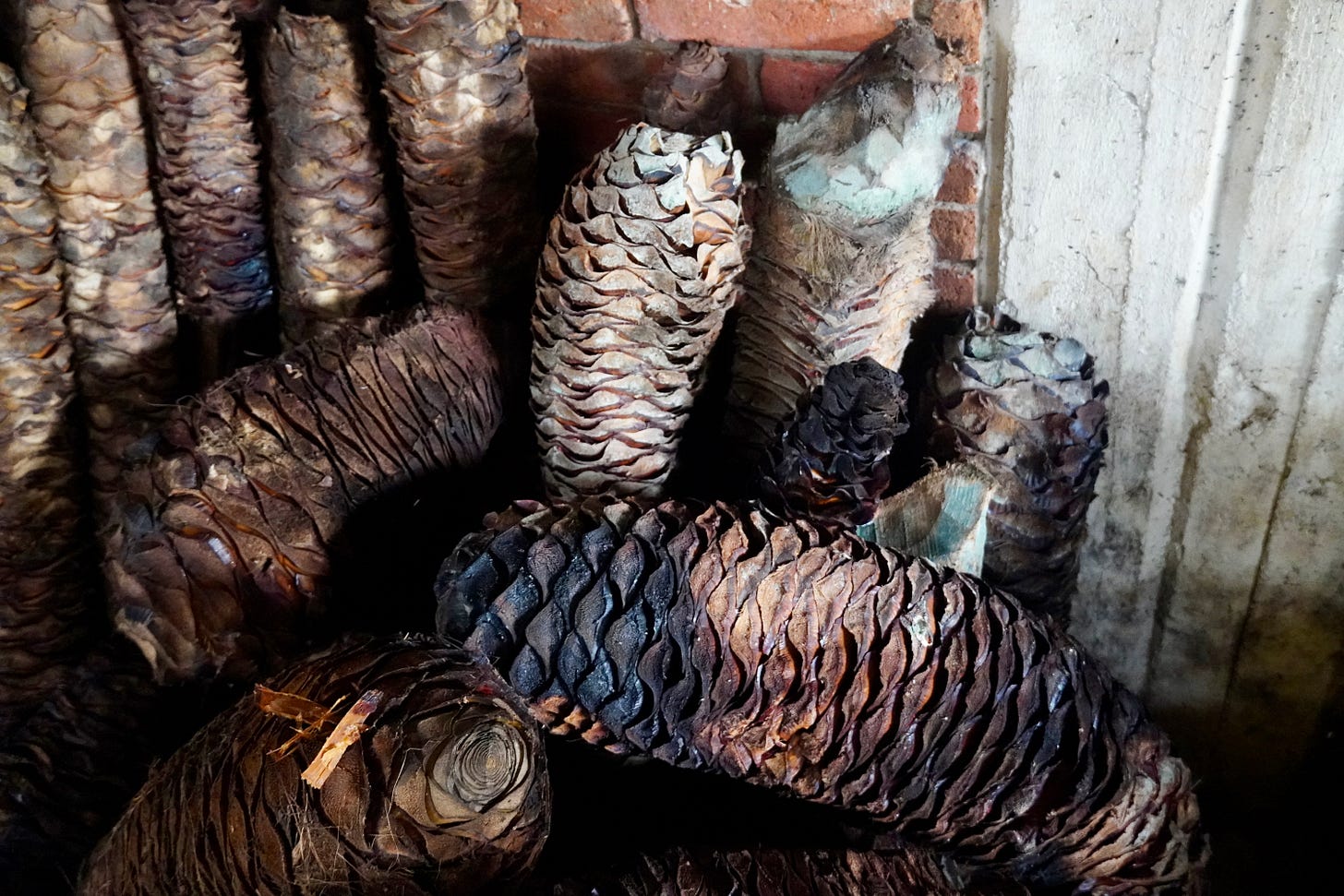
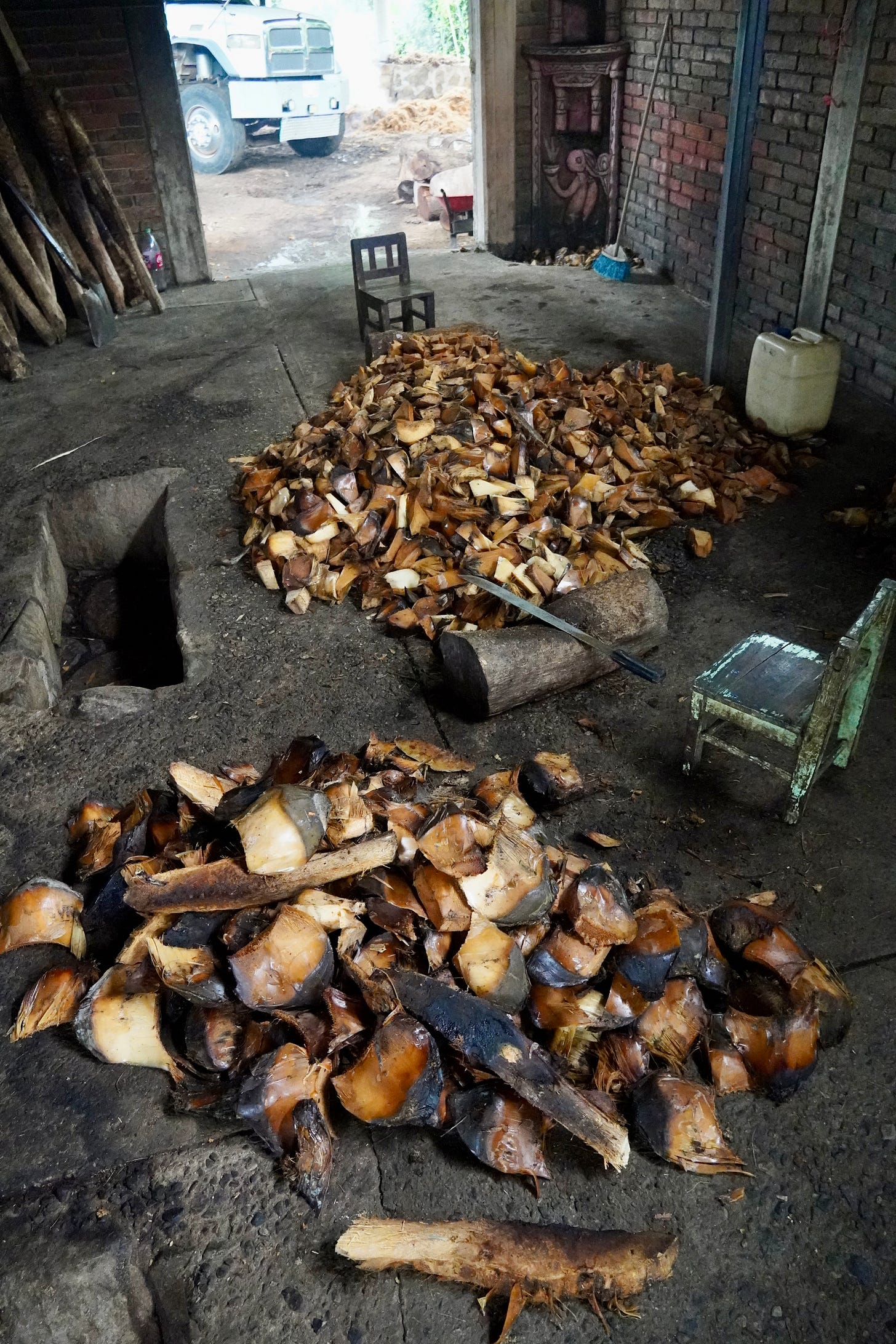
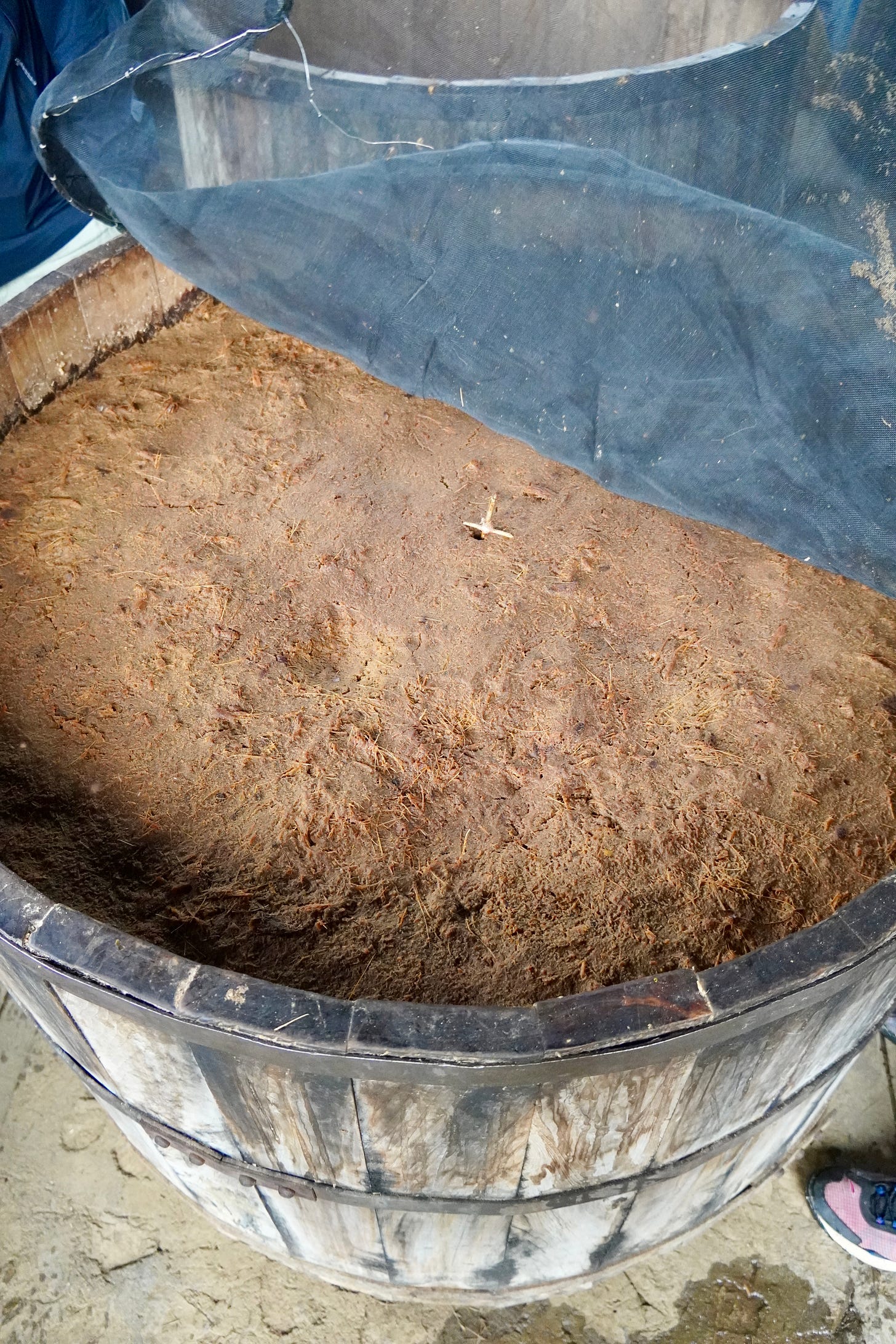
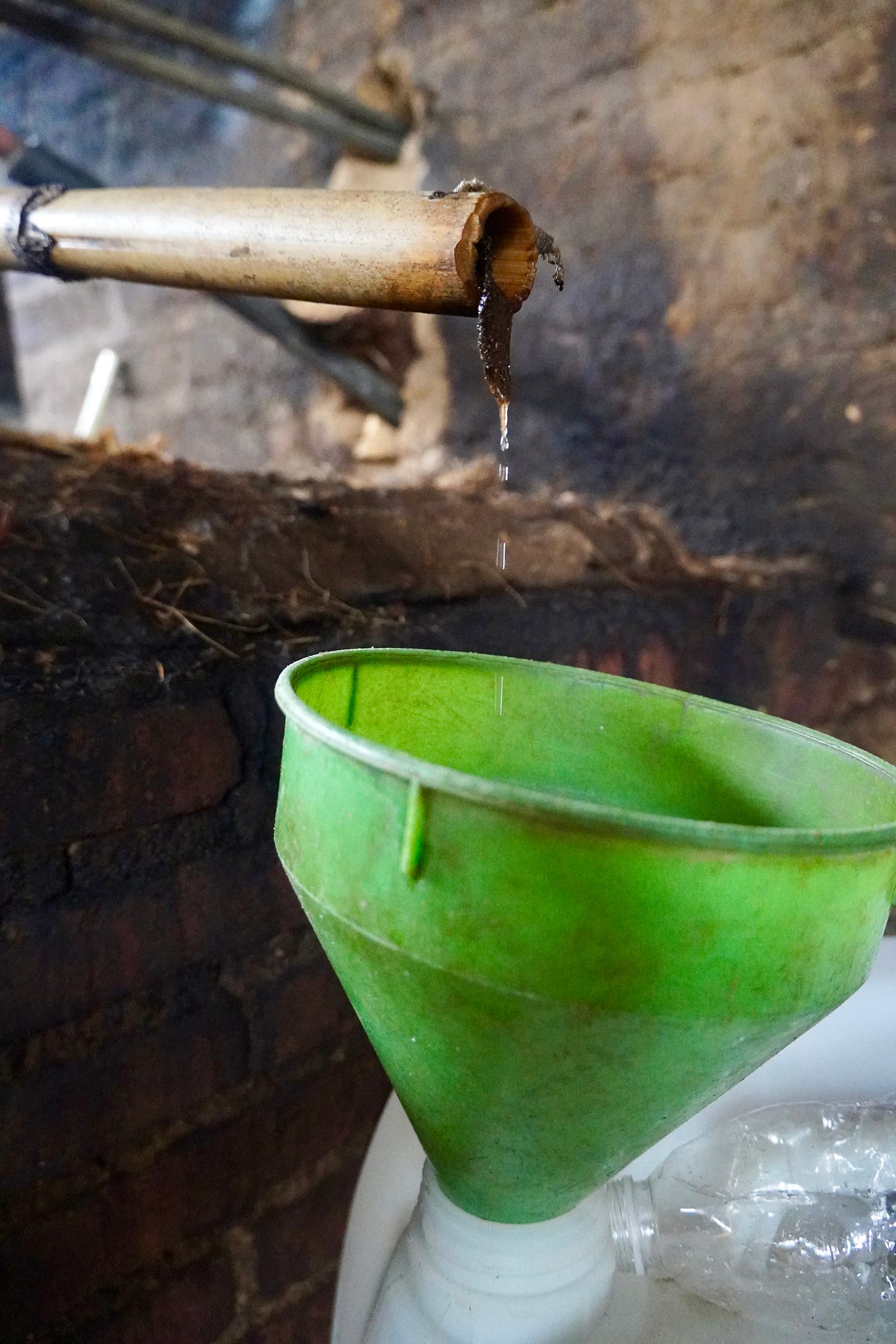



"But firm rules as to how we should eat and drink are for fascists and their apologists."
fantastic writing again, thanks for sharing
Love their distiller, really simple, very clever. Fantastic write up, thank you